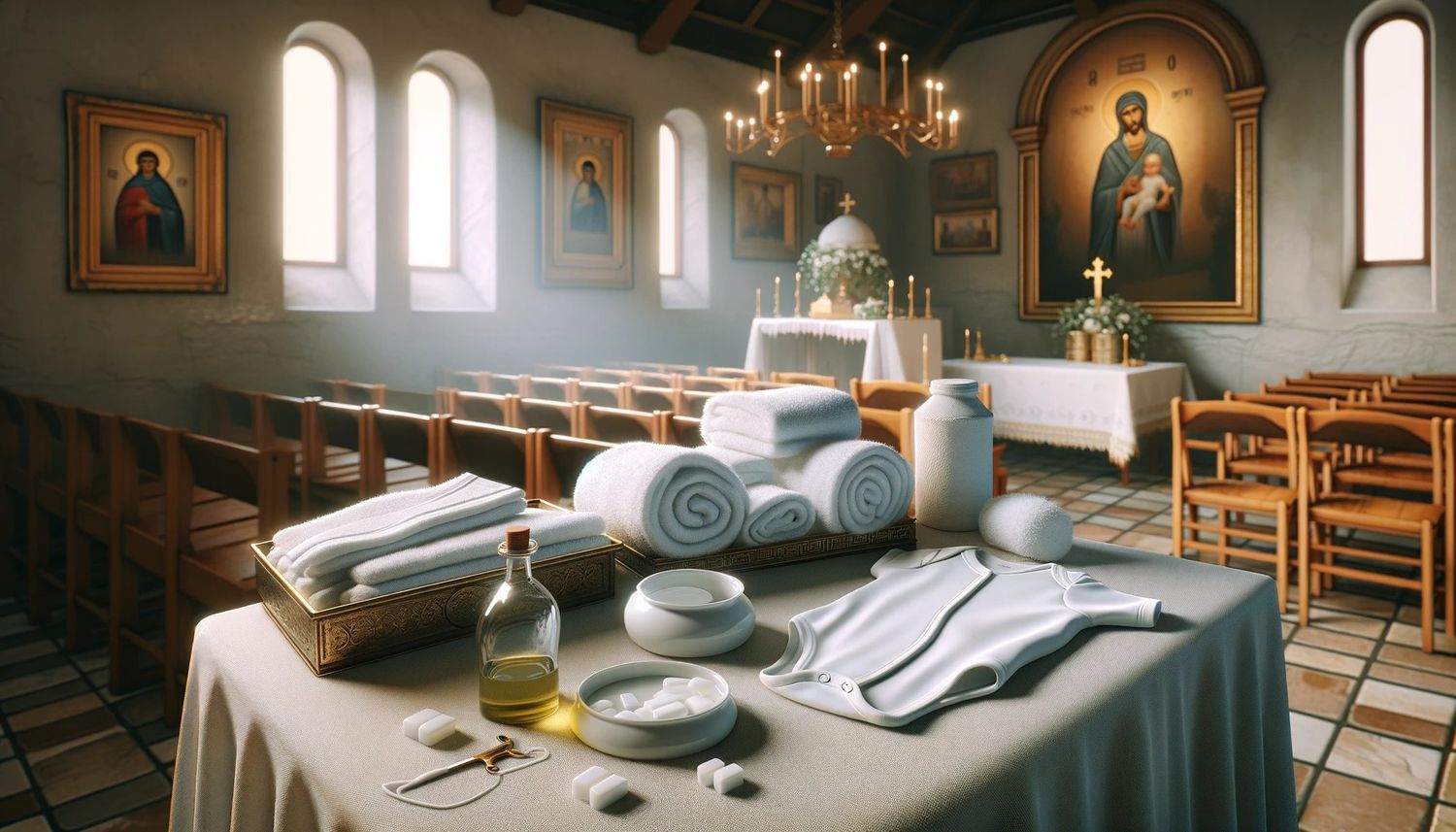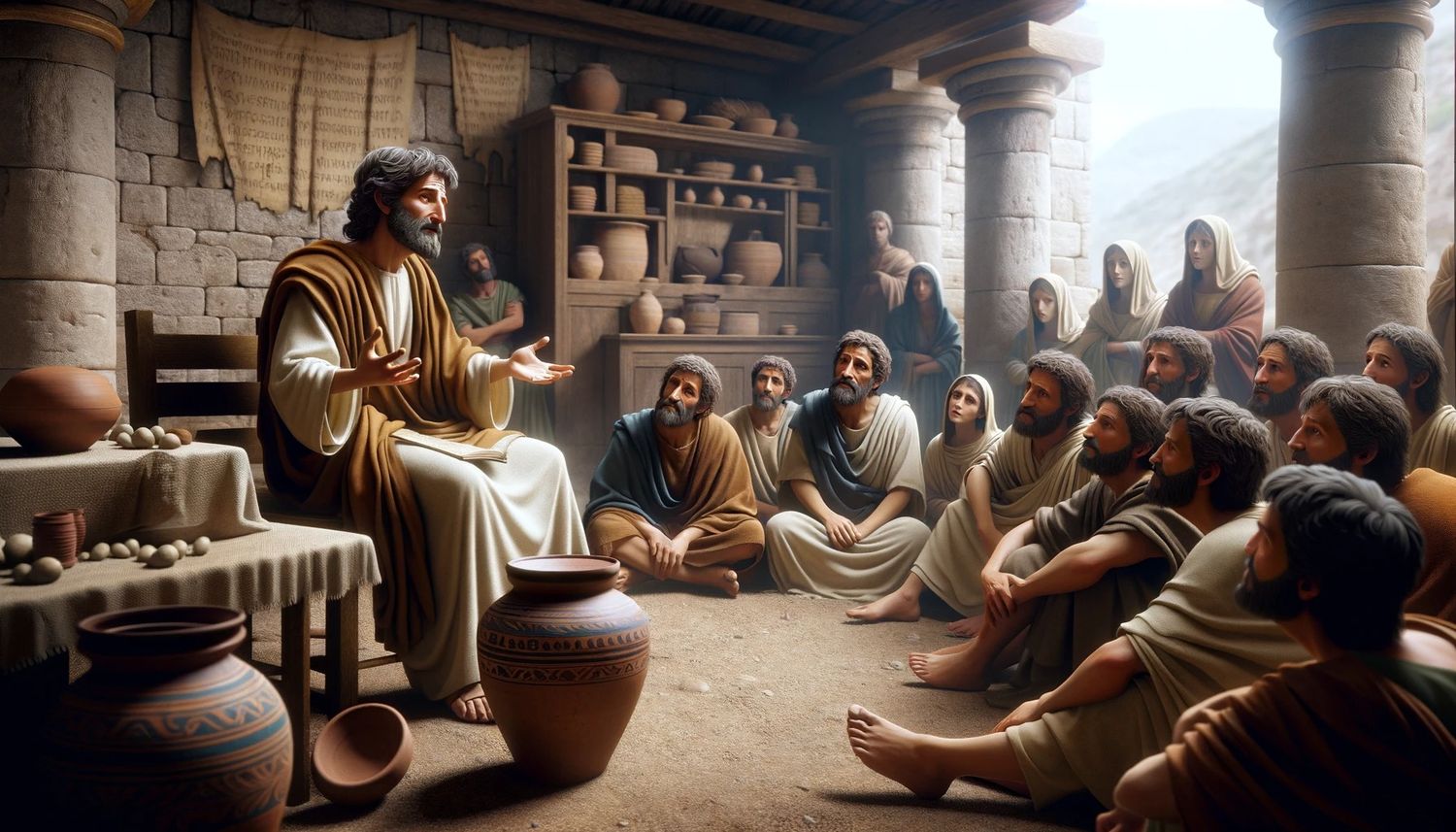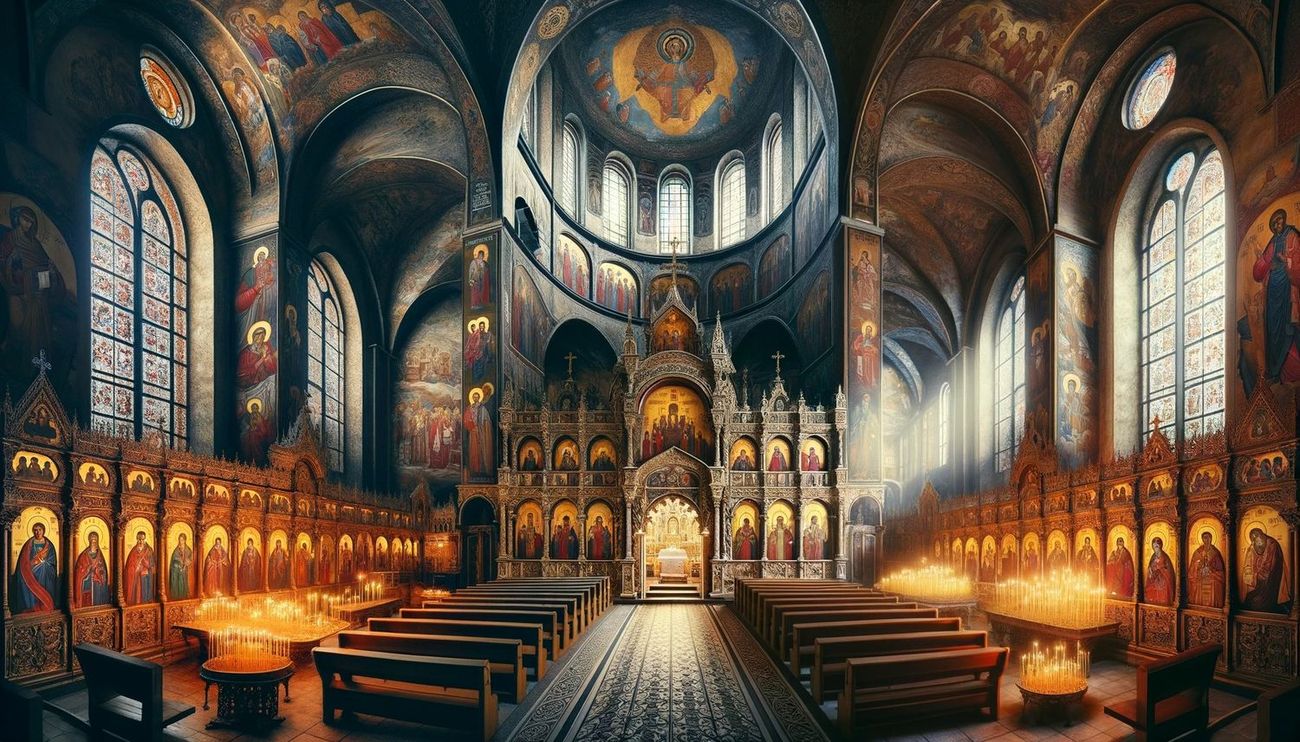Home>Theology and Spirituality>How Long Does A Greek Orthodox Baptism Take


Theology and Spirituality
How Long Does A Greek Orthodox Baptism Take
Published: February 28, 2024
Peter Smith, Editorial Director at Christian.net, combines deep insights into faith, politics, and culture to lead content creation that resonates widely. Awarded for his contributions to religious discourse, he previously headed a major organization for religious communicators, enhancing dialogue on faith's societal impacts.
Discover the duration of a Greek Orthodox baptism ceremony and the significance of each ritual in this insightful exploration of theology and spirituality.
(Many of the links in this article redirect to a specific reviewed product. Your purchase of these products through affiliate links helps to generate commission for Christian.net, at no extra cost. Learn more)
Table of Contents
Introduction
How long does a Greek Orthodox baptism take? This is a common question for those who are unfamiliar with the traditions and rituals of the Greek Orthodox Church. In this article, we will explore the significance of Greek Orthodox baptism, the preparations involved, the ceremony itself, and the post-baptism traditions and celebrations. Whether you are a member of the Greek Orthodox faith or simply curious about this sacred rite, understanding the duration and importance of a Greek Orthodox baptism can provide valuable insights into this rich religious tradition.
Read more: How To Take Orthodox Communion
The Significance of Greek Orthodox Baptism
Greek Orthodox baptism holds profound significance within the religious and cultural framework of the Greek Orthodox Church. It is considered one of the most important sacraments, marking the entry of an individual into the Christian faith and the community of believers. The baptismal ceremony is rooted in the teachings and traditions of the early Christian Church, symbolizing spiritual rebirth and the washing away of original sin. For Greek Orthodox Christians, baptism is not merely a symbolic ritual but a sacred and transformative experience that initiates the individual into the life of the Church and establishes a spiritual foundation for their journey of faith.
Theological Symbolism
The act of baptism in the Greek Orthodox tradition is deeply symbolic, representing the believer's participation in the death and resurrection of Jesus Christ. Through the immersion in or the pouring of water, the individual is united with Christ in His death, symbolizing the cleansing of sin and the emergence into new life. This act of immersion also reflects the believer's identification with Christ's burial and resurrection, signifying a spiritual union with the divine and the promise of eternal life.
Incorporation into the Body of Christ
Greek Orthodox baptism is not only a personal rite of passage but also a communal event. It signifies the incorporation of the baptized individual into the Body of Christ, the Church. This incorporation emphasizes the interconnectedness of believers within the Christian community, highlighting the importance of collective worship, fellowship, and spiritual support. The baptized person becomes a member of the Church, sharing in its traditions, teachings, and responsibilities, and contributing to the unity and vitality of the faith community.
Anointing with Chrism
During the baptismal ceremony, the newly baptized individual is anointed with chrism, a consecrated oil. This anointing symbolizes the bestowal of the Holy Spirit and the sealing of the baptized person with the gift of grace. It signifies the empowerment of the individual to live a life guided by the teachings of Christ and the virtues of the Christian faith. The anointing with chrism also serves as a visible sign of the believer's consecration and commitment to the path of spiritual growth and service within the Church.
Entry into the Eucharistic Life
Through baptism, the individual gains access to the Eucharistic life of the Church, participating in the sacramental life and receiving the body and blood of Christ. This entry into the Eucharistic community underscores the centrality of the Holy Communion in the spiritual nourishment and sustenance of the faithful. It signifies the believer's union with Christ and fellow believers through the sharing of the sacred meal, fostering a deeper connection to the divine and to the community of faith.
In summary, Greek Orthodox baptism is a profound and multifaceted sacrament that embodies theological symbolism, communal incorporation, anointing with chrism, and entry into the Eucharistic life. Its significance extends beyond the individual experience, encompassing the spiritual journey of the baptized person within the context of the Church and the broader Christian tradition.
Preparing for the Baptism
-
Selection of Godparents: The process of preparing for a Greek Orthodox baptism often begins with the selection of godparents, known as "nounoi" in Greek. Godparents play a significant role in the baptismal ceremony, serving as spiritual guides and mentors for the child or adult being baptized. They are responsible for nurturing the individual's faith, providing support and guidance in their spiritual journey, and actively participating in their religious upbringing. The godparents are chosen with great care, typically being close relatives or trusted friends who are committed to fulfilling their role in the life of the baptized person.
-
Baptismal Garments and Items: Another aspect of preparation involves acquiring the necessary garments and items for the baptismal ceremony. These may include a white baptismal gown or robe, a bonnet or cap for the infant, a small cross or crucifix, and a white towel or cloth. These items symbolize the purity, newness of life, and consecration associated with the sacrament of baptism. They are carefully chosen and prepared, often with attention to familial or cultural traditions, to enhance the solemnity and significance of the baptismal rite.
-
Spiritual Readiness and Instruction: Prior to the baptism, both the individual being baptized and the godparents receive spiritual instruction and guidance from the priest or spiritual leader. This may involve sessions of catechesis, where the theological and spiritual aspects of baptism are explained, and the responsibilities of the godparents are outlined. The aim is to ensure that the participants are spiritually prepared for the sacrament, understand its significance, and are committed to upholding the tenets of the faith within the context of the Greek Orthodox tradition.
-
Pre-Baptismal Rites and Prayers: In some cases, pre-baptismal rites and prayers are conducted as part of the preparation process. These may include the recitation of specific prayers for the well-being and spiritual readiness of the individual being baptized, as well as the offering of supplications for the guidance and wisdom of the godparents. These preparatory rituals serve to invoke divine blessings, purify the hearts and minds of the participants, and create a reverent and sacred atmosphere in anticipation of the baptismal event.
-
Logistical Arrangements: Practical arrangements, such as scheduling the baptismal date, coordinating with the church authorities, and inviting family and friends to witness the ceremony, are also essential aspects of the preparation. These logistical details ensure that the baptism proceeds smoothly and that the community of faith can gather to celebrate and affirm the initiation of the individual into the Greek Orthodox Church.
In essence, preparing for a Greek Orthodox baptism involves the thoughtful selection of godparents, the acquisition of baptismal garments and items, spiritual readiness and instruction, pre-baptismal rites and prayers, and logistical arrangements. These elements contribute to the meaningful and reverent observance of the sacrament, fostering a sense of spiritual anticipation and communal participation in the baptismal journey.
The Baptism Ceremony
The baptism ceremony in the Greek Orthodox tradition is a sacred and elaborate ritual that unfolds in a sequence of symbolic actions, prayers, and blessings. It typically takes place within the church, the spiritual home of the Greek Orthodox community, and is presided over by a priest who serves as the celebrant of the sacrament. The ceremony is imbued with theological significance, rich symbolism, and communal participation, reflecting the spiritual rebirth and incorporation of the baptized individual into the life of the Church.
Processional and Welcoming
The baptismal ceremony often commences with a processional, as the priest, accompanied by the godparents and the individual to be baptized, makes their way to the baptismal font. This procession symbolizes the entry of the participants into the sacred space of the church and the beginning of the transformative journey of baptism. The community of believers welcomes the procession, acknowledging the significance of the upcoming sacrament and offering their support and prayers for the baptized person.
Read more: How Long Does Confession Take
Renunciation and Affirmation of Faith
Upon reaching the baptismal font, the priest leads the individual (or the godparents, in the case of an infant) in a series of renunciations and affirmations. These statements involve the rejection of evil, sin, and the influence of darkness, and the acceptance of Christ, the Christian faith, and the teachings of the Church. This act of renunciation and affirmation signifies the conscious commitment of the baptized person (or their representatives) to embrace the path of Christian discipleship and to live in accordance with the principles of love, righteousness, and spiritual renewal.
Immersion or Affusion
The central act of baptism in the Greek Orthodox tradition involves the immersion of the individual in the baptismal font or the pouring of water over their head, accompanied by the invocation of the Holy Trinity. This immersion or affusion symbolizes the cleansing of sin, the spiritual purification, and the union of the baptized person with the death and resurrection of Christ. The use of water in the baptismal rite signifies the regenerative power of God's grace, the washing away of the old self, and the emergence of the new creation in Christ.
Anointing with Chrism
Following the immersion, the priest anoints the newly baptized individual with holy chrism, a sacred oil that has been consecrated by the bishop. This anointing represents the sealing of the baptized person with the gift of the Holy Spirit, signifying their empowerment to live a life guided by the virtues and gifts of the Spirit. The anointing with chrism also serves as a visible sign of the individual's consecration and their incorporation into the priesthood of all believers, as well as their participation in the prophetic and kingly mission of Christ.
Clothing in the Baptismal Garment
After the anointing, the baptized person is clothed in a white baptismal garment, symbolizing their newness of life, purity, and the putting on of Christ. This act of clothing the newly baptized individual underscores their spiritual transformation and their identity as a member of the body of Christ. The white garment also serves as a visual reminder of the call to live a life of holiness, righteousness, and devotion to God within the community of faith.
Read more: How Long Does Basilica Cistern Take
Lighting of the Baptismal Candle
As a final symbolic gesture, the priest lights a baptismal candle from the flame of the altar, representing the light of Christ that has illumined the life of the baptized person. The candle is presented to the newly baptized individual, or to their godparents, with the exhortation to "receive the light of Christ" and to walk as a child of light in the world. This act signifies the spiritual enlightenment, the guidance of the divine presence, and the call to bear witness to the truth and love of Christ in their daily lives.
Thanksgiving and Communal Blessing
The baptismal ceremony concludes with prayers of thanksgiving, communal blessings, and the participation of the faithful in affirming their commitment to support and nurture the newly baptized person in their journey of faith. The community expresses its joy and gratitude for the spiritual rebirth and incorporation of the individual into the life of the Church, affirming their welcome, love, and shared responsibility in fostering the growth and spiritual well-being of the baptized person.
In summary, the Greek Orthodox baptism ceremony encompasses a sequence of profound and symbolic actions, including the processional and welcoming, renunciation and affirmation of faith, immersion or affusion, anointing with chrism, clothing in the baptismal garment, lighting of the baptismal candle, and thanksgiving with communal blessings. Each element of the ceremony contributes to the spiritual significance and communal celebration of the sacrament, affirming the transformative power of God's grace and the communal support for the newly baptized individual.
Post-Baptism Traditions and Celebrations
After the solemn and transformative experience of the baptism ceremony, the Greek Orthodox tradition encompasses a variety of post-baptismal traditions and celebrations that reflect the joy, communal support, and spiritual significance of the sacrament. These traditions and celebrations serve to affirm the newly baptized individual's entry into the Christian faith and the Greek Orthodox community, as well as to foster a sense of belonging, love, and spiritual growth within the broader context of the Church.
Reception and Festive Gathering
Following the baptism, it is customary for the family and friends of the newly baptized person to gather for a reception or festive meal. This gathering provides an opportunity for the community to express their joy and congratulations, offer blessings and gifts to the baptized individual, and share in the celebration of this significant milestone. The festive atmosphere is marked by expressions of love, support, and communal affirmation, as well as the sharing of food, music, and fellowship.
Read more: How To Do An Orthodox Confession
Presentation of the Baptismal Cross
As a cherished tradition, the newly baptized individual is often presented with a baptismal cross, a symbol of their Christian identity and commitment. The cross, typically adorned with intricate designs and inscriptions, serves as a tangible reminder of the spiritual rebirth and incorporation into the life of the Church. The presentation of the baptismal cross is accompanied by prayers, blessings, and words of encouragement, emphasizing the significance of the cross as a sign of faith, hope, and divine protection.
Naming and Patron Saint Commemoration
In the Greek Orthodox tradition, the act of baptism is often accompanied by the bestowal of a Christian name upon the newly baptized person. This name, chosen with care and often bearing significance within the family or the Church calendar, symbolizes the individual's entry into the community of believers and their spiritual identity as a follower of Christ. Additionally, the baptismal name may be associated with a patron saint, whose feast day becomes a significant occasion for commemoration, prayer, and spiritual reflection throughout the life of the baptized person.
Offering of Special Prayers and Blessings
In the days and weeks following the baptism, it is common for the family and the Church community to offer special prayers and blessings for the spiritual well-being and growth of the newly baptized individual. These prayers may be conducted during church services, home visits by the priest, or family gatherings, invoking divine guidance, protection, and grace upon the baptized person. The communal support and intercessory prayers affirm the interconnectedness of believers and the shared responsibility for nurturing the faith and virtues of the newly initiated member of the Church.
Commemorative Traditions and Milestones
The celebration of the baptismal event often extends beyond the immediate post-ceremony gathering, encompassing commemorative traditions and milestones throughout the life of the baptized person. These may include the annual observance of the baptismal anniversary, participation in the sacraments of the Church, such as Holy Communion and Confirmation, and the engagement in acts of service, charity, and spiritual growth within the community. These milestones serve as opportunities for reflection, gratitude, and recommitment to the Christian faith, reinforcing the enduring significance of the baptismal experience.
In essence, the post-baptism traditions and celebrations within the Greek Orthodox tradition embody the communal support, spiritual nurturing, and joyful affirmation of the newly baptized individual's entry into the Christian faith and the life of the Church. These traditions and celebrations foster a sense of belonging, love, and shared responsibility within the community, affirming the transformative power of baptism and the ongoing journey of faith for the baptized person.
Read more: How Does A Baptism Work
Conclusion
In conclusion, the duration of a Greek Orthodox baptism is not merely a matter of time but a profound and multifaceted experience that encompasses theological symbolism, communal incorporation, anointing with chrism, and entry into the Eucharistic life. The significance of Greek Orthodox baptism extends beyond the individual experience, emphasizing the spiritual rebirth, the communal support, and the enduring commitment to the Christian faith. From the preparations involving the selection of godparents, the acquisition of baptismal garments, and spiritual readiness to the elaborate ceremony itself with its processional, renunciations, immersion, anointing, and communal blessings, the baptismal journey is a sacred and transformative rite that reflects the rich traditions and beliefs of the Greek Orthodox Church. The post-baptism traditions and celebrations further affirm the communal support, spiritual nurturing, and joyful affirmation of the newly baptized individual's entry into the Christian faith and the life of the Church. Overall, the duration of a Greek Orthodox baptism is a reflection of the timeless and profound significance of this sacred sacrament within the context of the Greek Orthodox tradition.










